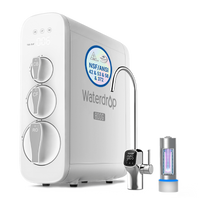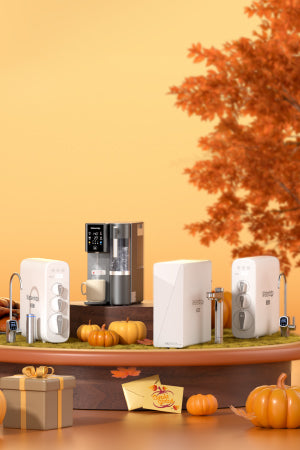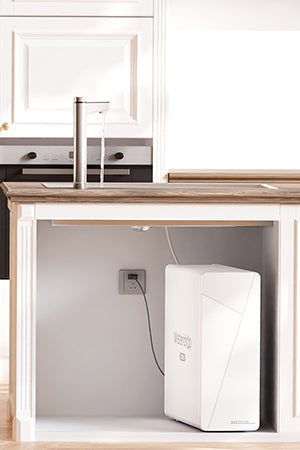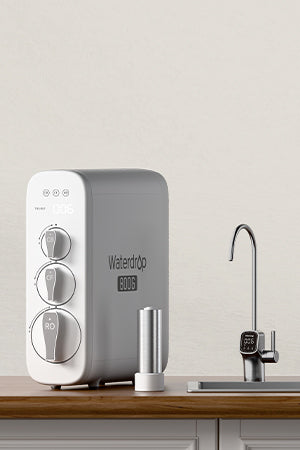Si vous vous demandez ce qu'est un système de filtration par osmose inverse en termes d'eau potable, Waterdrop est là pour vous fournir toutes les informations dont vous avez besoin.
Compte tenu du fonctionnement de notre société et de l'organisation de notre système civique, nous devons tous compter sur un nombre limité de sources d'eau potable. Pour la plupart, cela implique d'utiliser l'eau fournie par le service des eaux local, et pour certains, de boire à un puits privé. Quoi qu'il en soit, un point commun à tous est que la plupart de l'eau qui sort de nos robinets, si elle n'est pas traitée, n'est pas très propre et, dans certains cas, insalubre. Dans certaines situations, l'eau potable non traitée peut être dangereuse si elle est consommée en grande quantité.

Pour ceux qui sont conscients des risques liés à l'eau potable et à l'eau de cuisson, deux options s'offrent à eux : (1) déménager là où l'eau est propre, ce qui est non seulement peu pratique mais aussi de plus en plus difficile à trouver, ou (2) purifier l'eau qui arrive chez eux. L'une des stratégies émergentes pour purifier l'eau potable et l'eau de cuisson à domicile consiste à utiliser un système de filtration par osmose inverse. Waterdrop est l'un des leaders du secteur en matière de solutions de filtration d'eau pour les particuliers et les entreprises. Nous allons vous expliquer ci-dessous en quoi consiste un système de filtration par osmose inverse.
Quel est le concept derrière un système de filtre à osmose inverse ?
Avant d'entrer dans les détails de votre eau potable, il peut être utile de définir l'osmose.
Le Merriam-Webster la définit ainsi :
« Mouvement d'un solvant (tel que l'eau) à travers une membrane semi-perméable (comme celle d'une cellule vivante) vers une solution de concentration en soluté plus élevée qui tend à égaliser les concentrations de soluté des deux côtés de la membrane »
Dans la nature, ce processus se produit le plus souvent chez les plantes. Lorsque l'eau est présente dans le sol et que les racines des plantes l'absorbent, l'eau traverse la paroi de la racine, qui est une membrane semi-perméable. Ce faisant, l'eau se concentre avant d'être entièrement absorbée par la plante.
Le principe d'un système de filtration par osmose inverse est tout le contraire. Au lieu de produire une eau plus concentrée, il décompose cette concentration et fournit une eau moins concentrée, ou moins de substances, en plus de l'eau pure. Pour ce faire, l'eau est filtrée et pressurisée pour éliminer les contaminants généralement présents dans l'eau du robinet, qu'elle soit issue de réseaux publics ou de puits privés. En résumé, l'eau arrive du réseau public, par exemple, et avant d'atteindre le robinet, elle est pressurisée et filtrée à travers plusieurs filtres avant d'être séparée des eaux usées chargées de contaminants. L'eau propre et moins concentrée est ensuite acheminée vers le robinet (sur certains modèles) et les eaux usées sont soit rejetées à l'égout, soit renvoyées dans le réseau d'eau pour être recyclées.
Il s'agit évidemment d'une explication extrêmement simplifiée du système de filtre à osmose inverse. Nous allons donc expliquer ci-dessous le parcours qu'un verre d'eau potable typique emprunte depuis le service public jusqu'à la maison, en passant par le système de filtration d'eau et finalement dans le verre pour une boisson d'eau propre et sûre.
La première étape de l'osmose inverse
La première étape d'un système de filtration par osmose inverse est généralement appelée préfiltration. Cette étape vise à éliminer les sédiments présents dans l'eau du robinet. Des substances comme le chlore peuvent obstruer et endommager la membrane d'osmose inverse, que l'eau atteindra plus tard dans le processus. Par conséquent, pour compléter le processus de préfiltration, l'eau du robinet est pressurisée et passe à travers un filtre à charbon et un filtre à sédiments, réduisant ainsi sa concentration avant de passer à l'étape suivante. La pressurisation est nécessaire pour faire passer l'eau.
La membrane d'osmose inverse
Une fois la préfiltration terminée, l'eau exempte de sédiments passe par la membrane d'osmose inverse. Cette étape est cruciale pour tout système de filtration par osmose inverse. La membrane d'osmose inverse est conçue pour éliminer les particules de sédiments si petites qu'elles ont pu échapper à la préfiltration. Une fois cette étape terminée, l'eau est pure et parfaitement propre, débarrassée des sédiments et autres matières susceptibles de nuire à la qualité de l'eau.
Stockage et processus de post-filtrage
De là, l'eau est généralement acheminée vers un réservoir où elle restera jusqu'à ce que quelqu'un ouvre le robinet pour accéder à une eau propre, potable et de cuisson. Lorsque le réservoir est plein, le système de filtration par osmose inverse s'éteint partiellement. Lorsque quelqu'un ouvre le robinet, l'eau du réservoir subit ce qu'on appelle le post-filtrage, qui correspond essentiellement au nettoyage final et à la préparation de l'eau avant sa consommation. Lorsque le réservoir commence à se vider, le processus recommence.
Qu'est-ce qu'un système de filtre à osmose inverse élimine ?
Un système de filtration par osmose inverse élimine, selon le produit utilisé, environ 99 % des sédiments et autres substances de l'eau du robinet avant sa consommation. Les Centres pour le contrôle et la prévention des maladies (CDC) des États-Unis ont publié une
page d'information sur les systèmes de filtration d'eau . Selon cette page, un système de filtration par osmose inverse peut éliminer, et élimine souvent, les éléments suivants de l'eau du robinet :
- Sodium
- Chlorure
- Cuivre
- Chrome
- Plomb
De plus, un système de filtre à osmose inverse peut réduire les quantités des substances suivantes :
- Arsenic
- Fluorure
- Radium
- Sulfate
- Calcium
- Magnésium
- Potassium
- Nitrate
- Phosphoreux
De plus, les CDC indiquent qu'un système de filtration par osmose inverse est très efficace pour éliminer les protozoaires, les bactéries et les virus. Cependant, ce système ne doit pas être considéré comme un filtre efficace contre toutes les bactéries et tous les virus.
Pourquoi certains systèmes de filtration par osmose inverse ont-ils besoin d’un réservoir ?
En règle générale, un grand nombre de systèmes de filtration sur le marché sont équipés d'un réservoir de stockage, car la plupart de ces systèmes filtrent l'eau très lentement. Il n'est pas rare que le système ait besoin d'une minute ou plus pour filtrer et traiter seulement 85 ml d'eau. Ainsi, un verre d'eau de 350 ml prend généralement quatre minutes à remplir. La plupart des gens n'attendent pas aussi longtemps pour boire un verre d'eau, ni même plus longtemps pour remplir une casserole. Le réservoir permet d'obtenir une eau propre plus rapidement.
Waterdrop a innové sur ce système en introduisant le système de filtration par osmose inverse sans réservoir. Nos systèmes sont non seulement sans réservoir, mais aussi rapides et offrent un débit d'eau continu. Par exemple, notre système de filtration d'eau par osmose inverse G2 remplit un verre en 12 secondes et assure un débit d'eau continu aussi longtemps que vous utilisez le robinet. Notre
WD-G3-W est également sans réservoir. En général, moins vous avez besoin d'équipements, plus le système est performant. L'absence de réservoir permet aux consommateurs d'avoir un accès continu à une eau potable propre, sans avoir à se soucier du nettoyage ou du remplacement du réservoir.
Avantages d'un système de filtre à osmose inverse
Chacun sait que l'élimination des contaminants de tout ce que nous consommons présente de nombreux avantages. Moins nous buvons d'impuretés, meilleure sera notre santé, aujourd'hui et demain. Le système de filtration par osmose inverse présente d'autres avantages, dont nous allons énumérer cinq ci-dessous :
1.
Avantages environnementaux
Utiliser l'eau disponible chez soi présente certains avantages environnementaux. En effet, avoir accès à une eau potable propre et salubre dans cet environnement permet d'éviter d'acheter de l'eau en bouteille plastique, ce qui crée un énorme problème environnemental. De plus, certaines
études ont montré que l'eau en bouteille n'est pas plus sûre que l'eau du robinet non traitée.
2.
L’élimination du plomb est un énorme avantage
Nous y avons fait allusion plus haut, mais le principal avantage pour la santé d'un système de filtration par osmose inverse est peut-être l'élimination du plomb de l'eau potable. Extrêmement nocif, le plomb est interdit dans des substances comme la peinture pour la maison en raison de ses dangers. Voici quelques exemples de problèmes que le plomb peut causer :
- Lésions nerveuses
- Anémie
- Lésions des tissus cérébraux
- Hypertension artérielle
- Maladie cardiaque
- Maladie du rein
- Infertilité
En outre, le CDC a déclaré que les enfants sont particulièrement vulnérables aux dommages causés par l’exposition au plomb.
3.
Il élimine également le sodium
Outre le plomb, le sodium est également nocif, surtout s'il est consommé en grande quantité sur une longue période.
Live Sf Conscient a publié un article de scientifiques analysant les risques pour la santé liés à une consommation excessive de sodium. Ces problèmes de santé incluent des risques accrus pour les problèmes suivants :
- Hypertension artérielle
- Accident vasculaire cérébral
- Insuffisance cardiaque
- Ostéoporose
- cancer de l'estomac
- Maladie du rein
Il y a déjà suffisamment de sodium présent dans de nombreux aliments que nous consommons, donc en ajouter encore plus à partir de notre eau potable n’est pas une bonne idée.
4.
C'est vraiment bon
Les personnes qui boivent de l'eau filtrée par osmose inverse pour la première fois sont souvent extrêmement surprises, voire choquées, par la différence de goût avec celle de l'eau qu'elles ont bue la majeure partie de leur vie. En effet, elles ont principalement bu de l'eau chargée de différents contaminants et substances, et ces « ingrédients » influencent le goût de l'eau consommée. L'eau pure, sans substances, n'a presque aucun goût, mais d'une manière agréable et rafraîchissante, assez nouvelle et intéressante au premier abord.
5.
Cela profite à vos résultats financiers
Outre les dommages environnementaux et l'exposition potentielle aux contaminants liés à la consommation d'eau en bouteille, comme mentionné précédemment, son coût à long terme est élevé. Une autre alternative à l'eau du robinet consiste à faire appel à un service de livraison d'eau pour livrer régulièrement des réservoirs d'eau à votre domicile ou à votre entreprise. Cela a également un coût, et vous continuez à payer l'eau de votre domicile ou de votre bureau. Un système de filtration par osmose inverse vous permet d'éviter ces coûts et d'utiliser l'eau du robinet, généralement beaucoup moins chère que ces produits de consommation.
Système de filtration d'eau par osmose inverse WD-G3-W
749,00 $ CA 599,00 $
Est-il difficile d’installer un système de filtre à osmose inverse ?
Le terme « système de filtration par osmose inverse » paraît complexe pour ceux qui n'ont pas de formation scientifique ou biologique. C'est pourquoi, au fil des ans, des consommateurs se demandent s'ils pourraient installer correctement un tel système à la maison ou au bureau. Lorsque ces systèmes de filtration d'eau ont fait leur apparition sur le marché il y a plus de dix ans, leur installation et leur entretien nécessitaient du temps, du travail et des compétences. Depuis, nous avons beaucoup progressé.
Par exemple, Waterdrop propose des systèmes de filtration d'eau inversée qui s'installent en seulement 30 minutes et produisent une eau propre et savoureuse presque immédiatement. Cette facilité d'installation est due en partie à l'absence de réservoir, mais aussi au fait que nous fabriquons ces produits depuis des années et que nous souhaitons simplifier au maximum la mise en service de nos systèmes pour nos clients, dans les meilleurs délais.
De plus, nos systèmes de filtration d'eau relativement simples sont faciles d'entretien. Il vous suffit de remplacer le filtre de temps à autre, et notre indicateur intelligent vous le signalera. Le moment venu, il vous suffit de retirer l'ancienne pièce et de la remplacer par une pièce identique. Si vous savez changer une ampoule, vous pouvez également vous en charger.
Purifiez votre eau potable aujourd'hui
Rien ne remplace une eau potable propre, saine et délicieuse. Elle améliore votre humeur, votre santé et votre tranquillité d'esprit, sachant que vous et votre famille évitez les contaminants inutiles qui peuvent et vont présenter des risques pour votre alimentation et, par conséquent, pour votre santé. L'équipe de Waterdrop est toujours ravie de discuter avec vous de la façon dont un système de filtration par osmose inverse peut améliorer votre quotidien. N'hésitez pas à
nous contacter pour que nous puissions répondre à vos questions et vous accompagner vers l'eau potable que vous méritez.











































































